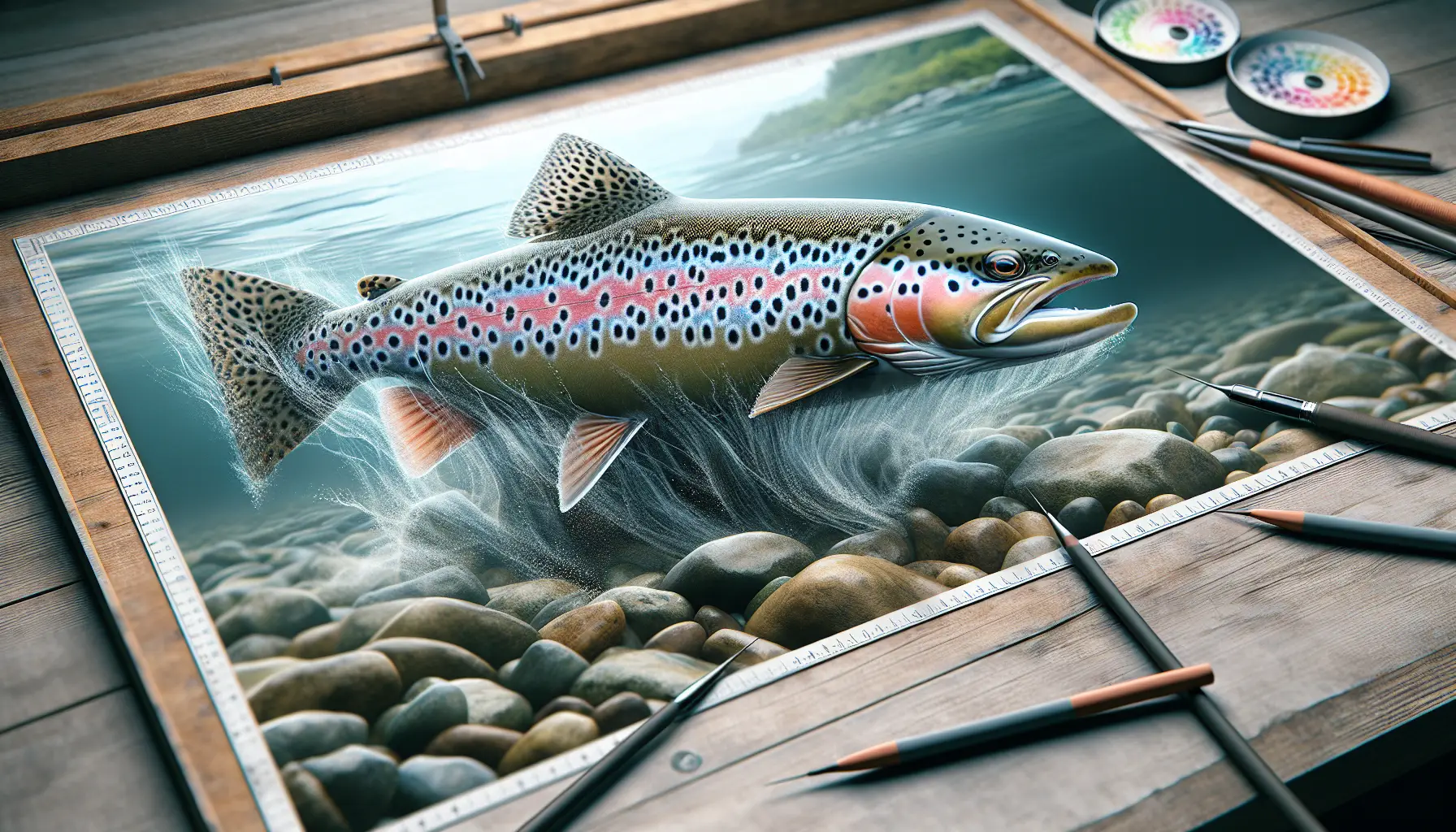Understanding Trout Feeding Behavior
If you’re a fly fisherman wanting to up your game, getting the lowdown on how trout eat is a big deal. Knowing their picky eating habits and how they act in different waters can really boost your chances of snagging more of them.
Selective Feeding Patterns
Trout can be as fussy as a foodie in a new restaurant, sizing up specifics of their prey like nobody’s business. They might zero in on how a fly floats along or how it’s planted in the water—kind of like they’re auditioning for a gourmet meal.
So, you gotta figure out if they’re in a mood where only the perfect drift gets their nod, or they’re ready to pounce the moment a fly comes into their view (Troutbitten). Sometimes, in those tiny windows when they’re actually eating, they’ll be picky about the fly style more than whether it drifts perfectly. So, cracking this code is key for successful fishing.
Behavior in Different Water Types
Trout have different personalities based on where they hang out, and knowing these quirks helps you switch up your fishing game for better results.
-
Rivers and Streams: Think of trout here as chill VIPs. They park themselves where they can kick back and let food drift their way. But they might also be real picky about how a fly drifts or looks, making you work that presentation to snag ’em.
-
Lakes and Ponds: In these calm spots, trout get more nosy. With all the time in the world to eye up your fly, they might be extra choosy about the look of the fly since the still water lets them get a close look.
-
Spring Creeks: These dreamy, clear waters demand your A-game. Since the water’s like glass, trout can see everything, and you’ll need to make stealthy presentations with subtle flies to sneak a bite.
Getting the hang of how trout act in these waters helps you pick the right fly and tweak your approach to bag those finicky fish. Fine-tuning your game to match their selective eating and their watery worlds gives anglers the smarts they need to outwit and catch these discerning fish.
Tailoring Fly Patterns
Figuring out how to tweak fly patterns can really give fly fishers an edge, especially when those picky trout are playing hard to get. Let’s chat about how little nymphs can make a splash in rough waters and the crafty moves you need for nymphin’ like a pro.
Small Nymphs in Turbulent Waters
Casting small, lightweight nymphs in choppy waters is like trying to balance a plate in a storm. You gotta get the tippet thickness, fly weight, and water depth just right. With all those crashing waves, trout don’t have much time to nab food. So, using a slightly beefier fly can be your best buddy in these situations (Troutbitten).
Ditch those fancy-pants micro leaders for a good ol’ mono setup. Short drifts let you take advantage of the fast currents since those speedy waters mean the trout have to hustle to eat.
Some things to think about:
- Heavier fly: Helps it dive quicker and stand out better.
- Short drifts: Give trout less time to suss out your bait.
- Versatile leader setup: Simple mono gear does the trick nicely.
| What To Do | Pro Tips |
|---|---|
| Fly Weight | Go a bit heavier |
| Drift Length | Keep it short |
| Leader Setup | Use mono |
Strategic Nymphing Tactics
To nail this nymphing game, understanding dead drifts is sorta like knowing when a joke is funny—sometimes it matters, but sometimes it doesn’t. When you’re dealing with nymphs, those whooshing waters give trout teeny bite windows.
When you’re strategizing nymphing, it’s all about:
- Picking the right nymph size and heft
- Letting the fly groove naturally with the flow
- Tweaking the depth so your fly hangs out in trout dining areas
Think about “high sticking”— where you keep the rod up to cut down on drag— and toss in some indicators to let the fly drift naturally. Going back and forth between weighted and non-weighted flies can mimic different bug stages, coaxing those trout out of their skepticism.
| Game Plan | Tricks to Try |
|---|---|
| Dead Drift | Make it look like it’s going with the flow |
| High Sticking | Cuts drag, ups your control |
| Fly Selection | Mix in both weighted and non-weighted flies |
With some savvy fly tweakin’ and strategic nymphin’, fly fishers can outsmart the fussiest trout and make their fishing trips both rewarding and fun.
Trout Selectivity Factors
Understanding Trout Behavior
Trout have moods, trust me. They can get super picky about what they eat. So, if you’re someone who’s trying to catch these fish, it might help to know what they’re thinking. For instance, are they more fussy about how the fly drifts or where it lands? Picture a trout hanging out next to a rock, waiting for a fly to float by. Sometimes, they care more about where the fly ends up rather than how smoothly it drifts by (Troutbitten).
Funny enough, some things can make them forget they’re about to chomp on a hook. They might just not care sometimes. It’s like they’re saying, “Eh, I see the hook, but I’m hungry”.
Efficient Fishing Strategies
Catch those finicky trout with some smart moves. Doug Swisher, the cool dude in the video, talks about snazzy tricks to snag trout from the surface or lurking in the depths. He’s all about being slick with the “Efficiency Factor” — which is a fancy way of saying, tie knots fast and keep false casts to a minimum. Less fuss, more fish! If your fly is chilling in the water more, you’re bound to have a good day.
He throws back to the old-school by discussing copper sleeves for casting. Way before those flashy nymphing lines showed up, this was the trick people used (Scientific Anglers).
Swisher also dishes on mastering water reading, spotting seams, and feeding hideouts. These aren’t just places; they’re hotspots. Trout love hiding there. Believe it or not, only a tiny sliver of the water has trout. So, being clued in on these spots just makes your day out way more rewarding.
Here’s a helpful glance at some core tactics for those fishing for elusive trout:
| Trick | Why It Rocks |
|---|---|
| Quick Knot Tying | More action in the water |
| Fewer False Casts | Maximizes your time fishing |
| Spotting Water Hotspots | Finds the fish fast |
| Use Right Gear | Better casting, more fish |
Getting inside the trout’s head and using these solid fishing moves can really up your game. Master these, and you’ll likely return home with quite the catch.
Mastery of Fly Presentations
Getting good at fly presentations is what separates the pros from the amateurs when it comes to tricking picky trout. This means knowing your bugs and using a bit of hatch strategy magic.
Entomology Basics
Fly fishing is a bit like dressing up for Halloween, but for fish – you gotta look the part to get the candy. Or in this case, catch the trout. It’s all about choosing the right fly to match what the fish are munching on.
Dry Flies:
These bad boys float on top like a cork, mimicking the bugs trout love to snack on – think mayflies, caddisflies, grasshoppers, you name it. They’ve got wings, or bits that look like wings, to keep them above water. They’re made with stuff like deer hair and light hooks to stay afloat, unlike wet flies that wanna dive (check out The Fly Crate for more).
Emerger Flies:
These are for when the bugs are halfway peeking out of the water, making their awkward teenage stage known to all. Emergers work just below the water, perfect for when fish are eyeing bugs trying to break free (consult The Fly Crate for a deeper dive).
Compound Hatch Strategies
Compound Hatches:
Here’s where things get interesting. Doug Swisher’s tips on watching the hatch can make you the Sherlock Holmes of the fishing world. It’s about knowing which bug’s partying on the surface and matching them with your fly (get more on Scientific Anglers).
Here’s a crash course on getting it right:
-
Mimicking Hatches:
-
Keep your eyes peeled for the main insect stars
-
Pick flies that look like the bugs you’ve spotted
-
Complex Hatches:
-
Sometimes there’s a bug buffet – spot as many as you can
-
Mix and match your flies to handle the insect variety show
Mix these basic bug facts with smart hatch tactics to give those trout exactly what they’re looking for, and you’ll be halfway there to landing the big one. It’s all in the little details that turn an average fishing day into a legendary one.

